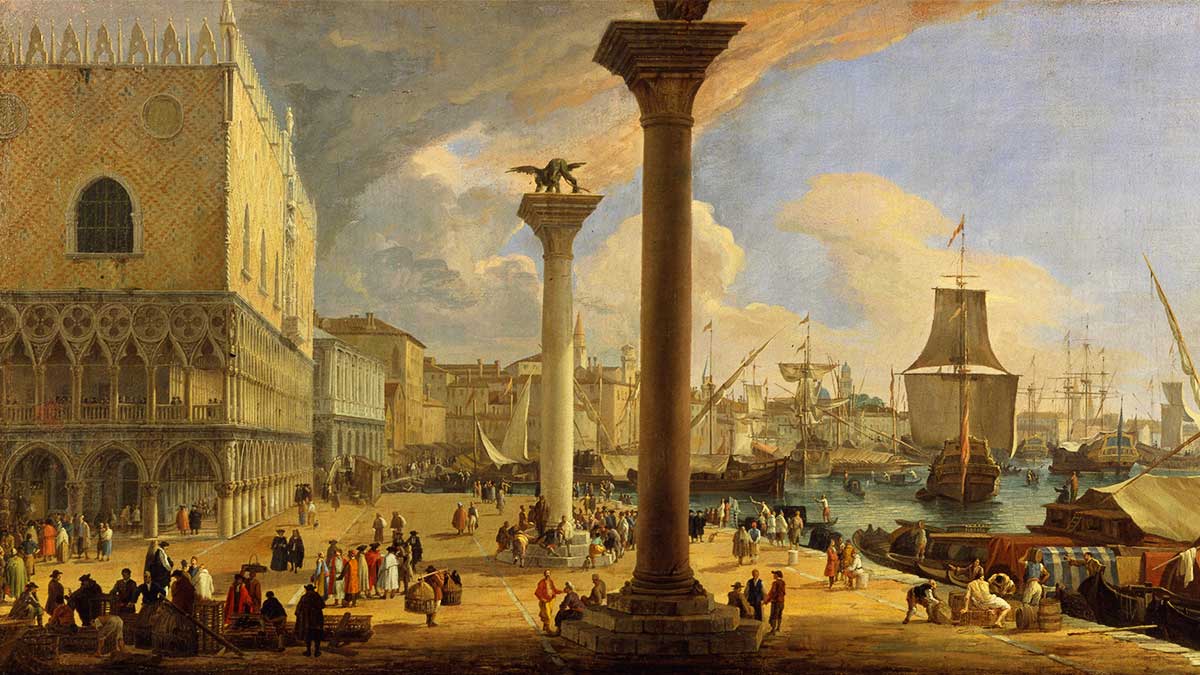La maggior parte delle aziende sarebbe felice di durare per secoli, come ha fatto la Repubblica di Venezia. Dal 697 al 1797 dC, l’acume tecnologico di Venezia, la posizione geografica e l’anticonformismo sono stati i punti di forza che hanno permesso alla Serenissima di prosperare. Ma quando il cambiamento arriva all’improvviso, può trasformare i punti di forza in debolezza e spazzare via anche storie millenarie di successo. In questo articolo pubblicato originariamente dall’Harvard Business Review, possiamo imparare una grande lezione dallo storico Impero Veneziano.
L’Arsenale, un’avanzata fabbrica di imbarcazioni, è stato il cuore pulsante dell’industria navale veneziana. Dal XIII secolo in poi, l’Arsenale ha nutrito la creatività e stimolato l’innovazione e l’imprenditorialità nella costruzione delle sue galere.
Inoltre, la posizione geografica della città ha contribuito a difendersi sia dagli invasori di terra che da quelli di mare. Questa ubicazione, costituita da una serie di isole circondate da una laguna paludosa, ha spinto anche a sviluppare un’economia basata sulla negoziazione e sul prestito (inusuale per il tempo), poiché non c’era abbastanza terra per sostenere l’agricoltura. Infine, la sua posizione al vertice del mare Adriatico ha permesso di diventare un fulcro di scambio vitale, collegando l’Oriente con l’Occidente attraverso il Mediterraneo.
Sicuramente quindi, l’impero Veneziano aveva una combinazione vincente di carte strategiche.
Ma, come moltissime realtà di successo, Venezia ha raggiunto un punto in cui si è maggiormente incentrata sullo sfruttamento rispetto che sull’esplorazione: i commercianti veneziani hanno seguito strade già battute per raggiungere il loro successo. Gli imprenditori hanno scelto di non allontanarsi dai percorsi tradizionali, limitandosi all’innovazione incrementale e concentrandosi sull’efficienza e l’ottimizzazione di ciò che già esisteva. Determinati ad accrescere rapidamente le proprie fortune, hanno premuto il piede sull’acceleratore invece di tracciare nuovi percorsi.
Ma verso la fine del 16 ° secolo il mondo stava cambiando: l’attenzione per le galee dell’Arsenale aveva un senso quando il Mediterraneo era la più importante rotta commerciale, ma l’invenzione dei galeoni permise ai paesi confinanti con l’Atlantico di impostare nuove rotte commerciali che non passavano attraverso l’Adriatico.
Questa nuova epoca di esplorazioni ha innescato l’inizio del declino dell’Impero Veneziano. Un enorme avanzamento nella tecnologia – le nuove navi potevano resistere in mare per mesi, anche anni – ha indebolito il vantaggio competitivo di Venezia e la misura strategica delle sue competenze.
L’adozione del galeone significava che la Serenissima fu improvvisamente svantaggiata dalla sua posizione all’estremità settentrionale del Mar Adriatico. Inoltre, il suo Arsenale non era più all’avanguardia per la tecnologia navale. L’importanza economica di Venezia si era bruscamente fermata finché Napoleone non la invase, portando l’Impero veneziano ad una fine ufficiale.
Qual è la lezione per gli imprenditori e per gli innovatori di oggi? Che se le aziende non si sforzano di esplorare nuovi orizzonti e uscire dalla confort zone, saranno destinate a fallire.
Se non si vuole essere colti di sorpresa, si deve riconoscere che il futuro sarà diverso dal passato. Il futuro è imperscrutabile, ambiguo e aperto a tutte le opzioni. Una mossa importante da parte di un concorrente o una nuova tecnologia, a volte sono sufficienti per distruggere un impero. Anche se il vostro business oggi è come un giardino curato nei minimi dettagli e racchiuso tra altre mura protettive, non state facendo abbastanza. La prossima occasione (o minaccia) può trovarsi al di fuori di quelle mura, all’incrocio disordinato di settori e mercati.
Gli imprenditori e gli innovatori di successo esplorano le tecnologie emergenti e nuovi modelli di business, cercando di mantenere il quadro generale in mente e diffidando dall’essere troppo efficienti e ottimizzati. Questa prospettiva li aiuta a promuovere modi non convenzionali di pensare, risolvendo i problemi e sfidando lo status quo. Sanno che l’obiettivo non è quello di inseguire un orizzonte fisso ma capire quando e come l’orizzonte si sposta quando si avvicinano esso.
Di seguito riportiamo l’articolo originale:
Most organizations would be happy to last for centuries, as the Venetian Republic did. From 697 to 1797 AD, Venice’s technological acumen, geographic position, and unconventionality were interlocking advantages that allowed the Most Serene Republic to flourish. But when change comes suddenly, it can turn strengths into weaknesses and sweep away even thousand-year success stories.
Venice’s military technology and the city’s pivotal location on the main trade routes of the time gave Venice several strong, mutually reinforcing advantages.
The Arsenal, an advanced naval munitions factory that anticipated by several centuries the production-line method of manufacture, was the beating heart of the Venetian naval industry. From the thirteenth century on, the Arsenal nurtured creativity and spurred innovation and entrepreneurship in the construction of its galleys.
The city’s geographic location helped it to defend itself from both land- and sea-based invaders. This location, consisting of a series of islands in a marshy lagoon, also pushed it to develop a (then unusual) trading and moneylending economy, since there was little land to support agriculture. And its position at the top of the Adriatic Sea allowed it to become a vital trading hub, connecting the East with the West via the Mediterranean.
If, as Michael Porter wrote, competitive advantage stems from how “activities fit and reinforce one another….creating a chain that is as strong as its strongest link,” then strategic fit is something that the Venetian Republic had in spades.
But, like a lot of successful entities, Venice reached a point where it focused more on exploitation than exploration: Venetian traders followed existing paths to success. Entrepreneurs chose not to move away from traditional pathways. Established practices and preferences became more popular than exploration and speculation. Merchants and traders played the game of incremental innovation by focusing on efficiency and optimization. Determined to grow their own fortunes rapidly, they pressed their feet to the accelerator rather than charting new courses.
But toward the end of the 16th century the world was changing in ways that would make Venice less relevant. The Arsenal’s focus on galley ships made sense when the Mediterranean was the most important trading waterway. Alessandro Barbero, professor of medieval history at the University of Eastern Piedmont, in Italy, notes that the galley remained for a long time the favorite vessel of Venetian navigators. But the invention of seafaring galleons allowed countries bordering the Atlantic to set up new trade routes that did not flow through the Adriatic.
This age of exploration triggered the beginning of Venice’s decline. One huge advance in technology — ships that could survive at sea for months, even years — weakened Venice’s competitive advantage and the strategic fit of its competencies.
The rise of the seafaring galleon meant Venice was suddenly disadvantaged by its location at the northern extremity of the Adriatic Sea. Moreover, its Arsenal was no longer at the cutting edge of naval technology. Venice’s economic importance had sharply contracted by the time Napoleon invaded, bringing the Venetian Empire to an official end.
What’s the lesson for entrepreneurs and innovators today? The stronger the assumption that the future will function as today does, the greater the gravitational force of the status quo. Organizations set in their ways slow down and never strive for new horizons. They are doomed to wither.
If you don’t want to be caught by surprise, you have to recognize that the future will be different from the past. The future is unfathomable, ambiguous, and open to every option. One major move by a competitor, or one new technology, is sometimes all it takes to end an empire. If your current business is like a carefully tended garden, with neat beds and high walls, that’s not enough. The next opportunity (or threat) may lie outside those walls, at the messy intersection of sectors and markets.
Entrepreneurs and innovators resist “success as usual” syndrome, exploring emerging technologies and new business models. They try to keep the big picture in mind and are wary of being too efficient and too optimized. This perspective helps them promote unconventional ways of thinking, solving problems, and challenging the status quo. They know the goal is not to chase a fixed horizon but to understand when and how the horizon moves as they approach it.


Leave A Comment
You must be logged in to post a comment.